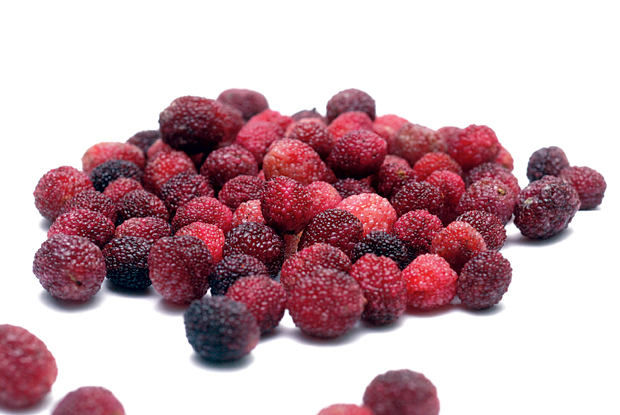
The street vendor cries out, “Kafal ayo, kafal ayo” (kafal’s arrived, kafal’s arrived). And in an instant, most of the children and ladies of households respond to the vendor’s call, the one who wanders carrying a woven bamboo basket laden with the fruit and calling out ‘kafal’ on his arrival. The interested shout back from their balconies and terraces saying, “aa dai parkhinusna” (hey brother, wait up). And with a handful of customers now eager to buy his offering, the kafal dai makes a fair bargain, measuring the fruit in a rusty tin jar in units known as manas. He usually charges Rs 60 for a mana of kafal, and off he goes to lure more locals to the popular Nepali snack, or box myrtle – which is a red colored berry that grows in the central Himalayas, most abundantly in Nepal, India and some parts of China. The fruit ripens during the months of May and June, making it a preferred afternoon munchy, mostly for its sweetness and often for its tangy flavor. Eating the fruit, however, can be tricky as the thin outer coating is all that there is for eating as a round and hard seed forms the core. This teeny fruit, which grows wild at altitudes ranging from 1500 m – 2500 m, has excellent medicinal values and other utilities. Ayurveda, the ancient science of traditional medicine practised in the Indian subcontinent, recognizes the kafal plant for its many properties such as vishagna (detoxifier), sita prasamana (to relieve cold sensation on the skin), stambhana (which works as an astringent), avedanasthapaka (which works as a pain killer), kanthya (beneficial for the throat), and sukra sodhana (which purifies seminal fluids). Besides the fruit, even the seed and the bark of its tree, in specific decoction, is benefial for edema, haemoptysis and cardiac debility, according to Susruta, the great Indian physician from around the fourth century A.D.
As the end of spring approaches, when the berry ripens, a Nepali Barbet sings, ‘kafal pakyo kafal payko’ (literally, the berry is ripe, the berry is ripe). The song is fascinating as it seems to address a sentimental tale of a brother and sister who lived in the mountains long ago. The legend goes that the brother goes away to join the army leaving his sister alone. Before leaving, he makes a promise to his sister that he would return every year if she sends him a message during the season when the kafal fruit ripens. He asks her to send him a message saying so.
As he leaves, it is the last time his sister ever sees of him because he gets killed in a battle never to return. But she persists and sends her message every year at the time when the berry ripens, in the hope of her brother returning, until the time of her demise.
Locals believe that her undying faith to see her brother continues. She, then returns as a bird (Barbet) in her next life, sending the message: ‘the berry’s ripe’ as the spring ends. The story may vary from one locality to another, but the anticiaption for the kafal to ripen, even if woven in stories, is what makes the berry special. It implies more than just a change of season.











